
CCAD Stories: Tobias Katz’s flexible approach takes him from the circus to the Katz Box
Influencers | What he's listening to | Three sharp designs | The value of critique
Tobias Katz (Industrial Design, 2017) thinks big. And the latest evidence — a project that will be unveiled at Chroma: Best of CCAD just days from now — shows this big thinker contemplating major ideas by going … small.
Katz, who graduates Columbus College of Art & Design this spring, is putting the finishing touches on a 160-square-foot tiny home, constructed from a shipping container.
Unlike traditional tiny houses — which often see occupants outgrow their confines — Katz’s tiny house design is intended to be modular. As a resident’s family expands (or their at-home business grows), additional shipping containers can be easily added to the structure to expand its square footage. And by a similar token, as the homeowner becomes an empty nester or experiences other life changes, the add-on containers can be easily removed. And because there’s already an infrastructure for moving shipping containers from place to place, homeowners who are looking to relocate (but love their domicile) can move their home at a minimal expense.
It’s an idea he’s had percolating since his first year at CCAD, and one for which he’s managed to get $30,000 in in-kind support from some 18 companies hailing from as far away as Australia.

Katz has also assembled a team of his peers — Paul Tenwalde (Master of Fine Arts, 2018), Elizabeth Cansfield (Advertising & Graphic Design, 2018), Katie Schwendeman (Advertising & Graphic Design, 2018), Gail Shamon (Industrial Design, 2017), Josh Smukal (Cinematic Arts, 2019), and Serenity Strull (Cinematic Arts, 2019) — to help him with everything from graphic design to photography to video documentation of the project.
"They're professional ... they're absolutely incredible. I wanted to show what talent we have and what drive we have here and what can be facilitated if you just talk to somebody.” he said.
Not too shabby for someone who, just a few short years ago, was planning on a career in the circus.
You read that right.
From age 9 to 17, Katz, a native of Pickerington, Ohio, pursued circus training in gymnastics, dance, and other forms of movement. But his junior year of high school, just as he was readying himself for applying to school for professional circus training, he was sidelined by an injury — a broken fibula.
So he took another creative direction. The Pickerington Central High School student had been hanging around the art room with friends, and with the encouragement of a teacher there (Matt Young, who has assisted with Katz’s tiny house project), Katz discovered that he had a knack for making jewelry.
In his senior year, Katz signed up for Advanced Placement Studio Art (his first high school art class); later Young convinced Katz to attend National Portfolio Day.
Although Katz had been considering skipping art school altogether, Tom Gattis, Dean, School of Design, persuaded him to major in Industrial Design at CCAD.
“He said, ’You know, you could really make thousands of dollars doing jewelry on your own, but if you come to CCAD, we can show you how to make millions. We can teach you to mass-produce a design that’s perfect.’ Katz recalled. “That’s not something you can do on your own. … I could give myself a critique, but I can’t give myself a critique that I can get by going to five professors.”
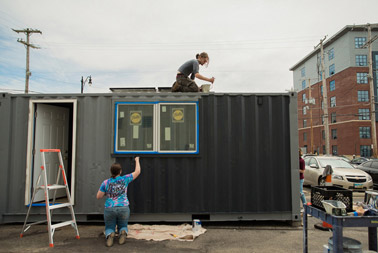
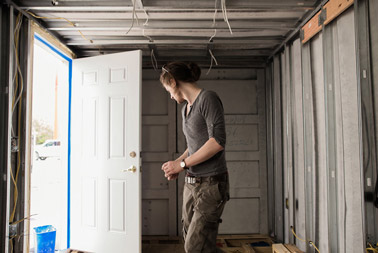
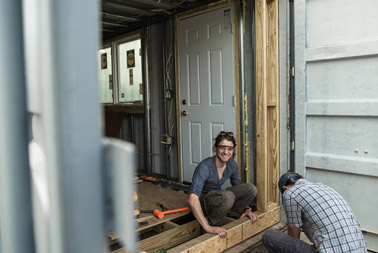
He never looked back.
Since starting at CCAD, Katz, who has a minor in Interior Design, has taken on projects such as a cell phone dock that naturally amplifies the phone’s speaker (the assignment was to make a styrofoam prototype; Katz made his from walnut) and a home design project for the Columbus Dispatch Home & Garden Show. With every assignment, Katz has sought to gain a new skill or hone an already existing one.
He said he learned early on that at CCAD, “If you put in a lot, you will get a lot. If you put in nothing, you won’t get anything. … And I want to get a lot out of this education. They are investing in me as an artist, as a designer, and I really want to prove what I can do. I want to be challenged and prove not only what a student can do, but what a designer in the 21st century can do.” he said.
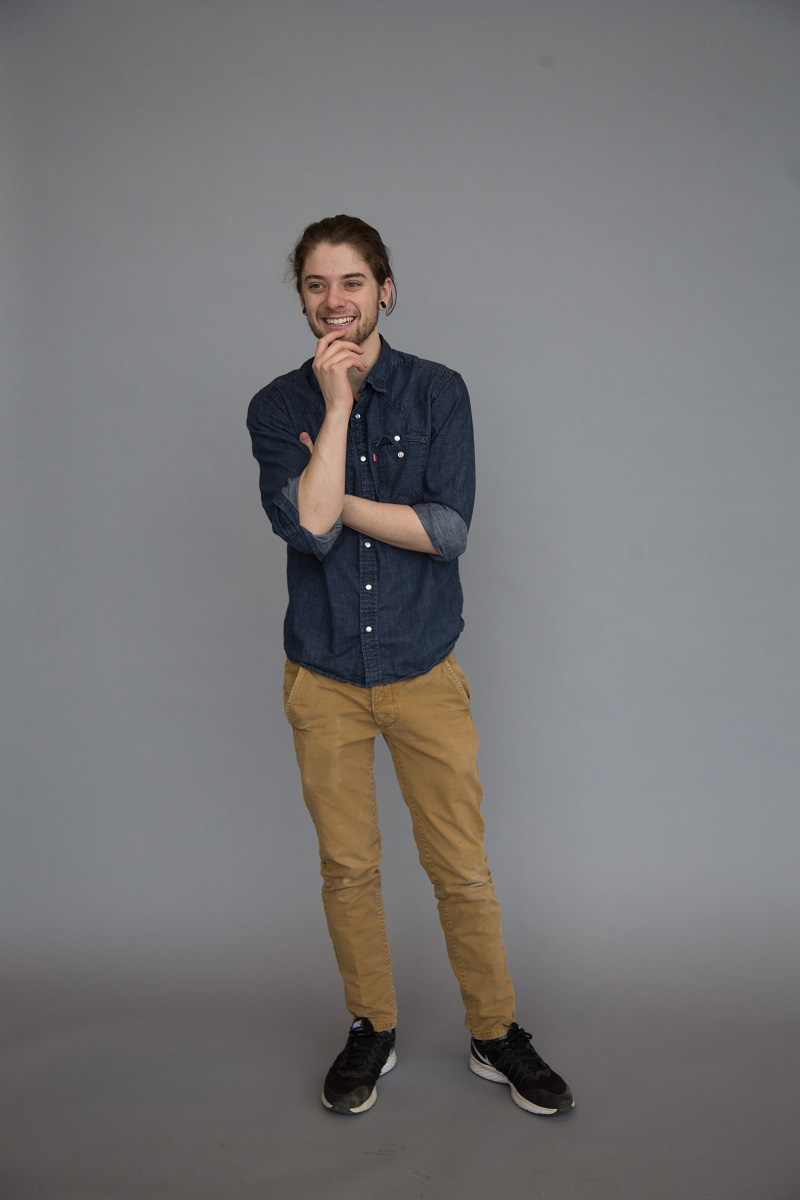
With graduation looming, Tobias Katz (Industrial Design, 2017) is busy with the finishing touches on his senior capstone project (his innovative idea: a modular tiny house constructed from the shell of a shipping container).
Katz’s four years at Columbus College of Art & Design have been marked by smart, outside-the-box thinking. Below, he discusses three projects that stand out in particular:
Two-Week Dresser
Katz was in a furniture design class the fall of his junior year that had a semester-long assignment: make one item of furniture.
“I was like, ’That’s not a challenge. I’m going to make an item of furniture every three weeks,’” he said.
He ended up making five items of furniture, but still had two weeks left in the semester. He decided he needed to do something else.
“So I said, ’I’m going to make a dresser in two weeks, and it’s going to hold two weeks’ worth of clothing and be made of 4’ by 8’ plywood.’ And with that, I created this dresser that I’m still using, and I really love it. My dad was housesitting for me and sent me a picture of the dresser, saying, “Where did you get this? I want one.” And I was like, “Dad, you saw me build this.” And he was like, “Oh my God, I forgot!” Yeah, because you saw it in plywood and now it’s been laminated and finished and painted.”
That was a great moment, said Katz, because his dresser doesn’t look handmade. “It looks like factory-made stuff. And if I were to make it now, I’d make it better. … But it was sort of a turning point. It proved to me that I could make something real. … This was my first fully, 360-degree finished piece that looked ’real.’ ”
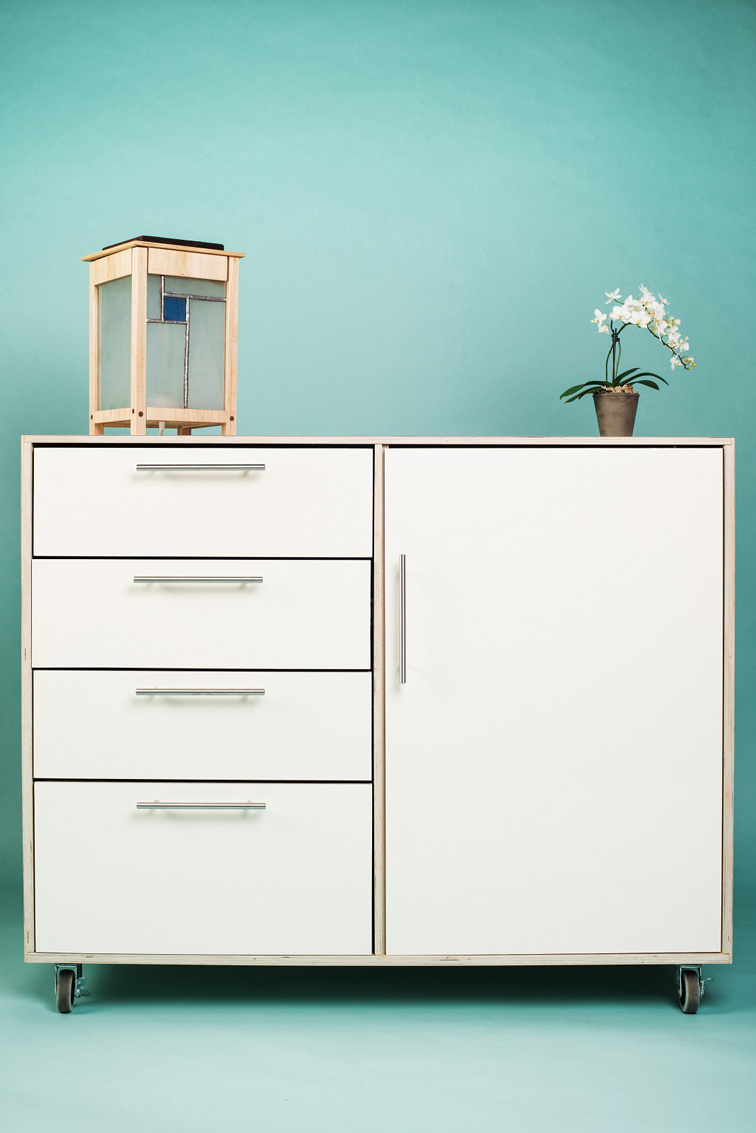
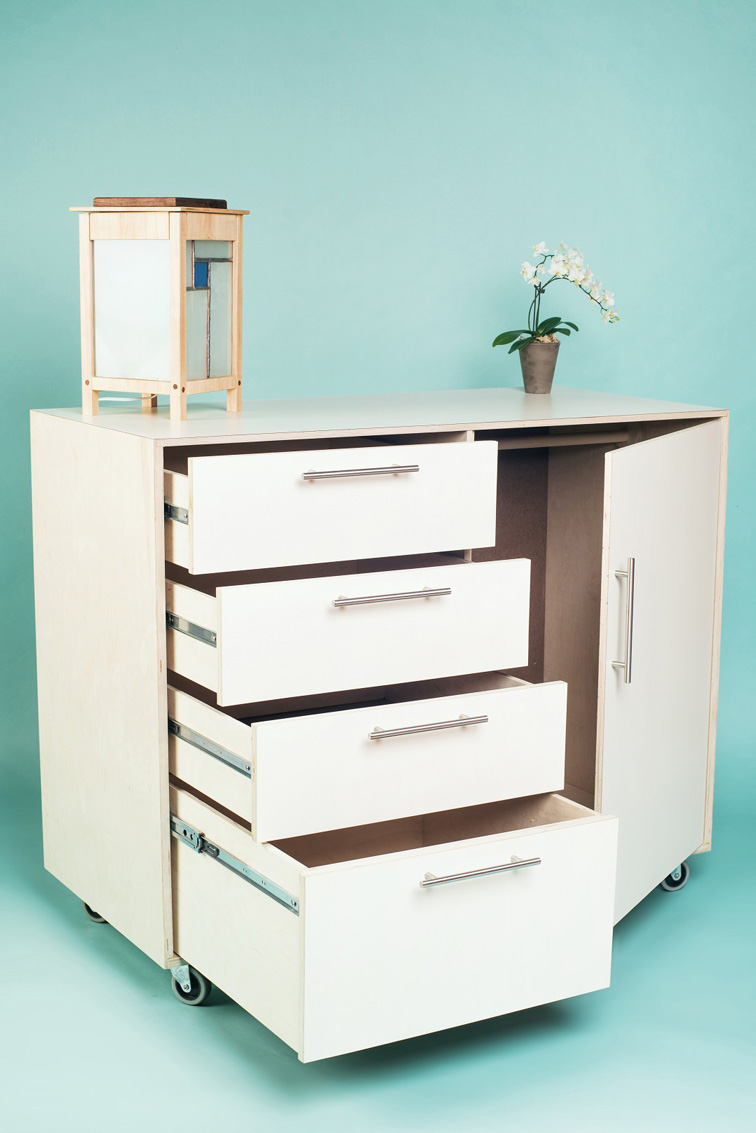
Bent Leg Table
While in the furniture class, Katz was also taking a class in glass. “You kind of suck the first two years you do it, because you’re learning not to be terrified that there’s a piece of molten glass at the end of the pipe. So you have to do it for a year or two before you’re comfortable, because it’s not a normal experience,” he said.
But Katz had become comfortable working with glass and decided he wanted to incorporate the material into his furniture designs. First, he made a table with a sunken glass flower vase in its center.
“It turned out really good but it wasn’t done,” he said. “The glass wasn’t fully straight, it was chipped, and the metal wasn’t perfectly welded. I was still learning.
“Then I decided that I really wanted to bend wood. I’ve done straight wood projects, I’ve done plywood projects, but I’ve never bent wood. So I came up with this design where I would — you know the ice buckets at hotels — I redesigned one of those to hold a bottle of champagne, but would fit into a table. ... By doing this, I was like, ’I really have to get better at blowing glass, I have to get better at making things, wood-wise.’ ”
The final product, made of maple and walnut, was designed with multiple types of joins, bent legs, and glass.
Moreover, the table is a flat-pack design, so it can be moved or shipped easily. That’s a lesson Katz learned after attending a job fair his junior year. The prospective employers were critical of how difficult it would be to ship a metal table he’d designed.
“That really taught me, ’Oh crap, I could have the best design in the world but unless you can get it to someone, what are they going to buy it for?’ ” he said. Now, “Everything that I design has to be able to be moved. Ideally it could be moved by one person.”
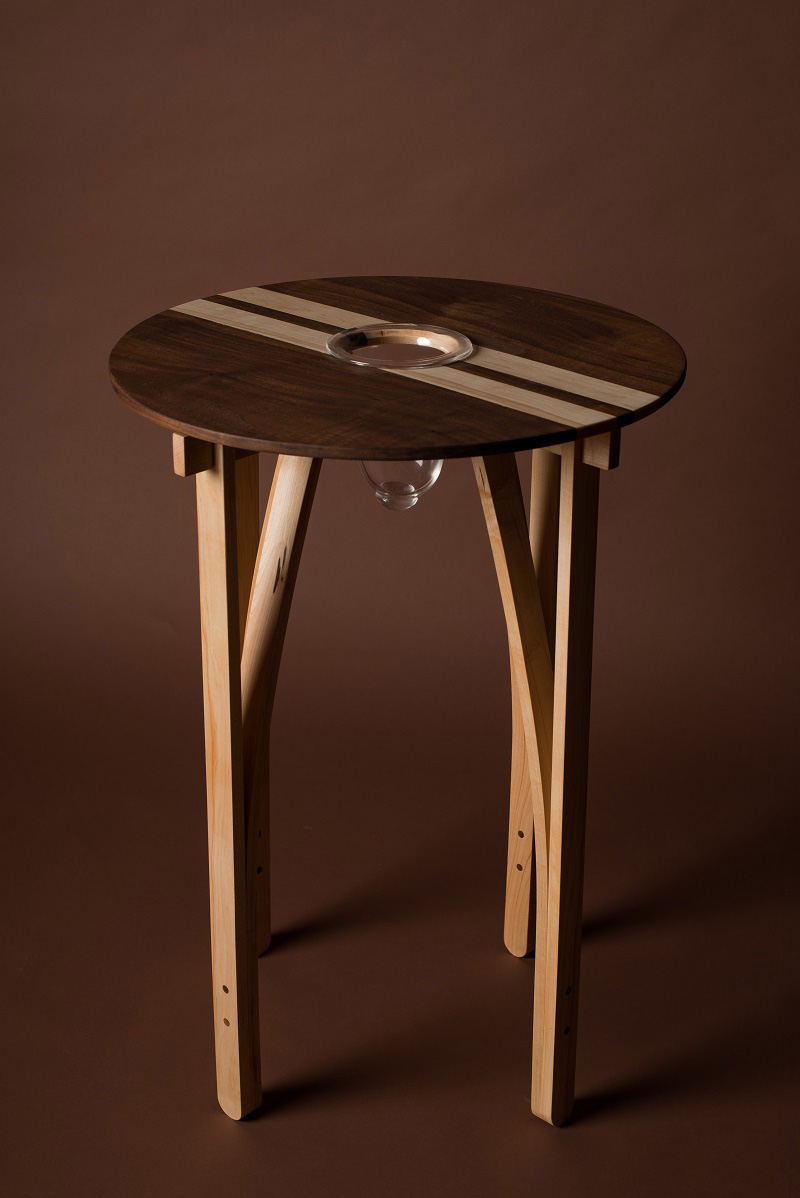
Ergonomic Tagliol
You’re only as good as your tools, Katz said. So when an Industrial Design class assignment asked him to make a prototype handle design — for a spatula, a drill, a gear shift, or the like, he thought, “I don’t want to just make a handle, I want to make something I’m going to use.”
At the same time, his sophomore year, Katz was in his first glass class. “I sucked, and I thought, ’Well, what can I make my life easier with?’ The tagliol (a paddle-shaped tool used to sculpt solid glass) we have at this school is all metal and it heats up after 3-4 times with using it. It heats up and hurts my hand after using it. So I thought, ’How can I diffuse that heat? Oh, make a heat-resistant handle and make a tagliol.”


Katz made a silicone-cast tagliol out of heat-resistant silicone, heat-resistant paint, and steel for the blade.
“This was all so I could be better with glass, so my vessels could be nicer,” he said. “You are only as good as your saw blade. If you have a rough cut of wood, it doesn’t matter how nice your furniture, is. You still need to sharpen your blade. You need a pen, or you can’t write. So I realized I need to make something to make my work better. That’s what kind of just pushed me into getting better at glass. Then I made four or five different tools to help me move at a rapid production of cylinders."

Tobias Katz's Top 5 Creative Influencers
Elon Musk, entrepreneur, inventor, engineer, and investor | Twitter |
Zaha Hadid, architect
Henry David Thoreau, writer, philosopher, abolitionist, surveyor, and historian
William Morris, textile designer, writer, translator, and socialist activist
Buckminster Fuller, architect, systems theorist, writer, designer, and inventor

Although Tobias Katz (Industrial Design, 2017) has found success with his work — including, most recently, his tiny house prototype, which will be unveiled next week at Chroma: Best of CCAD — that’s not to say that his designs have been created in a vacuum.
Katz values the role of making an already good design great. (Indeed, that was a major reason why he decided to attend Columbus College of Art & Design.)
“I’m here to be challenged,” he said. “You should get critiqued. You should feel uncomfortable in one or two critiques if your work isn’t solid.”
Industry professionals won’t blink an eye about offering up criticism, “and you need to hear it now, when it’s constructive,” he said. “You can learn from it, and build upon it. And that way, you’ll look even more attractive to employers. If your work has been vetted 10 times at CCAD and then you talk to an employer, you’ll already have the answers to the questions they have. But if you ignore the critique, they’re going to ask you the same things.”
And Katz, who is minoring in Interior Design, said he’s found particular success in reaching across disciplines to get perspective from a variety of CCAD faculty members.
“Oftentimes, I’ll get another professor to look at my work who isn’t the teacher,” he said.
For instance, when making furniture and housewares in a glass class, “it’s a Fine Arts class, so no one in that class can critique me, ’Oh, that bowl rim is too high.’ ” So, he sought insight from Interior Design Chair and Assistant Professor Greg Thune, has worked for Pyrex.
By a similar token, Joel Gundlach, Professor of Industrial Design and Interior Design, “makes furniture for every sort of house or boat. If you have a furniture question, he’s an expert,” Katz said.
“I remember, we did a backpack project my sophomore year, and I used to go to Suzanne Cotton (Chair and Associate Professor of Fashion Design) to get advice because no one in Industrial Design knows how to sew. … Because we’re CCAD and everyone is friendly, she was happy to show me the machine and teach me a few things.”
“All these kind of things happen at the school, you just have to seek it out,” he said.
Read more in our series CCAD Stories. Discover more about the CCAD Student Agency. Learn more about CCAD's Industrial Design program or apply here.
Post date
May 2, 2017